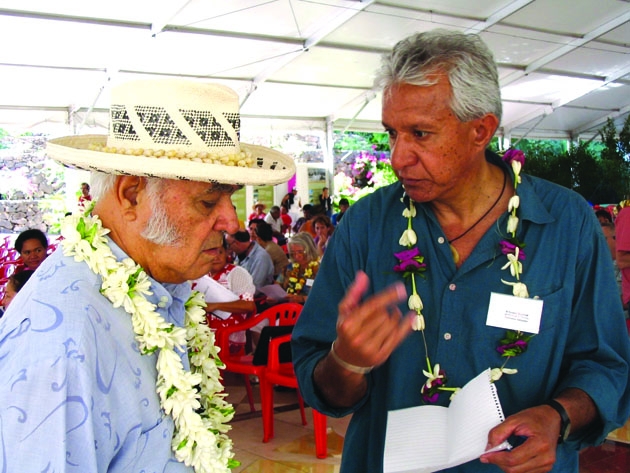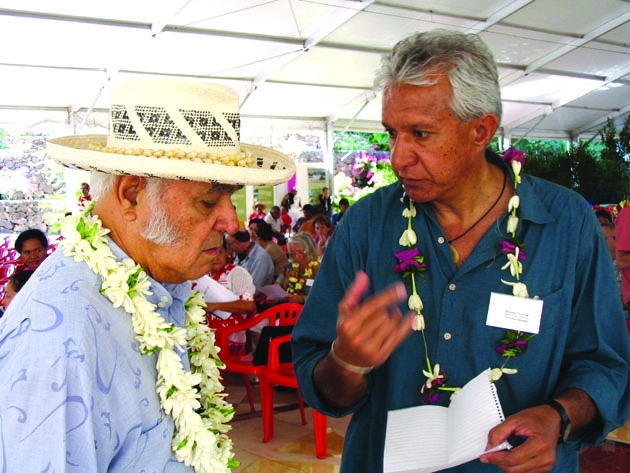AFTER more than 310 nuclear detonations across the region, the era of nuclear testing in the Pacific ended in 1996. Since then, the nuclear issue has dropped off the agenda for many people, with attention re-focussed on climate change and other environmental hazards.
Across the region, however, a band of activists has continued to campaign for environmental remediation at the nuclear test sites. They’ve also sought medical assistance and compensation for the civilian and military personnel who suffered adverse health effects from their work at the sites, during the 50 years of Cold War nuclear testing.
In recent years, this band of campaigners has shrunk, as age and ill-health has caught up with the generation who led a defining regional movement of the 20th century – the movement for a Nuclear Free and Independent Pacific.
After a long struggle with cancer, Roland Oldham died in Tahiti on 16 March, aged 68. Oldham was President of Moruroa e Tatou, the association of former Maohi workers from the Moruroa and Fangataufa nuclear test sites. The death of one of French Polynesia’s leading anti-nuclear campaigners is just one of many in recent years – in Marshall Islands, French Polynesia and Australia. These campaigners, however, have inspired younger people born after the end of testing. The torch has been passed to a new generation, who have recognised that the radioactive legacies of nuclear testing with be with us for many years to come.
Moruroa e Tatou
Tanemaruata Michel Arakino was born on Reao, an island not far from Moruroa Atoll. For 17 years, Arakino worked with the French military unit responsible for collecting biological samples at the nuclear test site, to determine the spread of radioactive particles. Working as a scuba diver, he plunged into the lagoon at Moruroa Atoll to collect samples of water, seaweed and sediments, just hours after underground nuclear tests had been detonated deep in the atoll.
Arakino reported: “In my job, I was regularly in the so-called ‘hot spots’ to gather samples from the ground and the sea for biological testing on Moruroa and Fangataufa Atolls. It is likely that while diving to gather plankton above ground zero, I swallowed or breathed in radioactive particles. In no case did my senior officers inform me of the risks I might incur.” Arakino’s story is just one example of the dirty, difficult and dangerous jobs allocated to Pacific islanders in support of the nuclear testing programs. Thousands of Maohi workers staffed the test sites at Moruroa and Fangataufa during thirty years of French nuclear testing. Five years after the last test, the association Moruroa e Tatou (Moruroa and Us) took up their cause. Roland Oldham co-founded the association in July 2001 with John Taroanui Doom and Bruno Barrillot. They spent years challenging successive French governments and local Tahitian leaders who refused to address the health and environmental consequences of nuclear testing.
Roland was a driving force in the campaign for reparations for the Maohi workers who suffered adverse health effects, finally leading to the passage of France’s Morin compensation law in 2009. Trade unionist, political campaigner, blues guitarist with the band Atomic Blues – he was a man of many parts and a true Pacific warrior. In a final interview, he stated simply: “In spite of all the mistakes I’ve made in my life, I’ve tried to learn from
them. I think that in all I’ve done, I’ve tried to bring a bit of happiness to others.”
Roland’s death follows the loss of his key collaborators. On Christmas Day 2016, the death of John Taroanui Doom meant the Pacific lost a leading scholar, religious leader and anti-nuclear advocate. John witnessed the first French atmospheric test at Moruroa in July 1966. That moment led to a lifetime’s support for nuclear survivors, through Moruroa e Tatou and ecumenical work through the Pacific Conference of Churches (PCC) and
World Council of Churches (WCC). The death of Bruno Barrillot in March 2017 robbed the association of another key supporter – Bruno wrote numerous books documenting the environmental damage of French nuclear testing and the impact on the health of the Maohi people of French Polynesia.
Throughout the era of nuclear testing, French officials argued that there was no danger arising from France’s 193 nuclear tests. At the time, these claims were backed by French Polynesia’s longserving President Gaston Flosse and key ministers like Edouard Fritch – the French territory’s current leader. But Tahitian anti-nuclear campaigners have been vindicated in their concerns. In a stunning statement to the French Polynesian Assembly last November, President Fritch admitted that successive governments led by Gaston Flosse had lied about the health and environmental effects of nuclear testing: “For 30 years we lied to this people that these tests were clean. It was us who lied and I was a member of this gang! And for what reason did we lie? Because our own leader had seen a bomb explode.”
Roll call of champions
For fifty years between 1946 and 1996, there were more than 310 nuclear tests. The roll call of nuclear sacrifice zones across the region is long: Bikini, Enewetak, Johnston, Monte Bello, Maralinga, Emu Field, Malden Island, Christmas (Kiritimati) Island, Moruroa and Fangataufa.
The roll call of anti-nuclear champions is also spread across the region. Artists and teachers like the late Teresia Teaiwa and Epeli Hau’ofa have highlighted the way that collective regional identity as Pacific islanders was reinforced and reaffirmed through struggles against nuclear testing, the dumping of nuclear waste and other threats to the ocean environment.
Last year saw the death of Aboriginal elder Yami Lester, blinded by the Totem 1 British nuclear test in 1953. For decades, Lester campaigned for the rights of indigenous people affected by the UK nuclear tests conducted on Aboriginal land in South Australia. Lester was a key witness before the 1985 McClelland Royal Commission into the tests.
While some Aboriginal people lived in contaminated zones for up to six years after the end of testing, others had been relocated to coastal towns away from their traditional lands. The Royal Commission recognised that the denial of access to land for displaced people “contributed to their emotional, social and material distress and deprivation.” Many Marshall Islanders were also exiled from their contaminated homelands. After the 1954 Bravo test, Lemeyo Abon was one of the children contaminated by radioactivity, rubbing fallout into her hair like shampoo. Later relocated from Rongelap atoll, she began a decades-long odyssey which has left many Rongelapese still living in exile. Sadly, Mrs Abon died in February 2018, depriving the world of one of the few remaining witnesses from the Bravo test.
Successive RMI leaders have called for further compensation from the United States, but the Marshall Islands has also lost its outspoken champions. The death of Ambassador Tony de Brum in August 2017, a prophet on disarmament, climate change and Micronesian sovereignty, has been followed by that of Bill Graham, who died on 1 March 2018, the 64th anniversary of the Bravo hydrogen bomb test on Bikini Atoll (spreading contamination across the nation, Bravo was the United States’ largest ever nuclear detonation). Graham served as public advocate for the Marshall Islands Nuclear Claims Tribunal, and was a key architect of the new Republic of Marshall Islands Nuclear Commission.
Young people step up
In the 1970s, students from the University of the South Pacific (USP) played a key role in initiating the Nuclear Free and Independent Pacific movement. Today, the Marshall Islands Students Association (MISA) at USP has taken up the challenge of educating a new generation of Pacific students about the residual radioactivity on contaminated atolls in the Pacific. For those willing to return to their home islands, this pollution restricts the use of local food sources, due to the concentration of radioisotopes in the food chain. Inspired by the Pacific Climate Warriors, young people around the region are campaigning on climate change. But there is a strong connection between sea level rise and nuclear contamination, because all the nuclear powers dumped radioactive material and contaminated soil into the ocean or shallow burial sites. As they dismantled their nuclear test site in 1996, the French military dumped more than 2,600 tonnes of nuclear-contaminated material into the waters off Moruroa and Hao atolls. In Australia, parts of the desert around Maralinga are still fenced because of
plutonium contamination.
In the Marshall Islands, Runit Island in Enewetak Atoll hosts a massive concrete dome which covers tons of nuclear contaminated waste. The radioactive legacy of US nuclear tests on Enewetak was buried under concrete in the mid-1970s, in a giant crater created by a nuclear blast. Today, however, the dome is cracking, leaching contaminants into the ocean environment. In her 2018 poem ‘Anointed’, young Marshallese poet Kathy Jetnil Kijiner mourns the damage to Runit: “You were a whole island once. Who remembers you beyond your death? Who would have us forget that you were once green globes of fruit, pandanus roots and whispers of canoes? Who knows the stories of the life you led before?”
Jetnil-Kijiner was one of many young activists from the Pacific who played a crucial role in lobbying for the new Treaty on the Prohibition of Nuclear Weapons (TPNW), which was adopted by the United Nations in July 2017. Long-time campaigners like Fiji’s Vanessa Griffen and Tahiti’s Roland Oldham were accompanied by younger activists, who travelled to New York to lobby governments as they negotiated the new treaty.
Karina Lester, a proud Yankunytjatjara-Anangu woman and daughter of the late Yami Lester, came to New York bearing a petition from people across Oceania. It urged governments to include provisions in the treaty to aid the survivors of nuclear testing. This lobbying led to a key section in the treaty obliging parties to assist nuclear survivors, with the preamble recognising “the disproportionate impact of nuclear-weapon activities on indigenous peoples.”
When it is ratified, the treaty will open new avenues for assistance to nuclear survivors. For this reason, despite the deaths of its three founders, Moruroa e Tatou will continue its work. At the association’s next general meeting, the Presidency may be taken up by the former PCC general secretary, Reverend François Pihaatae. Time moves on, but the torch still burns.
…..to read more buy your personal copy at

